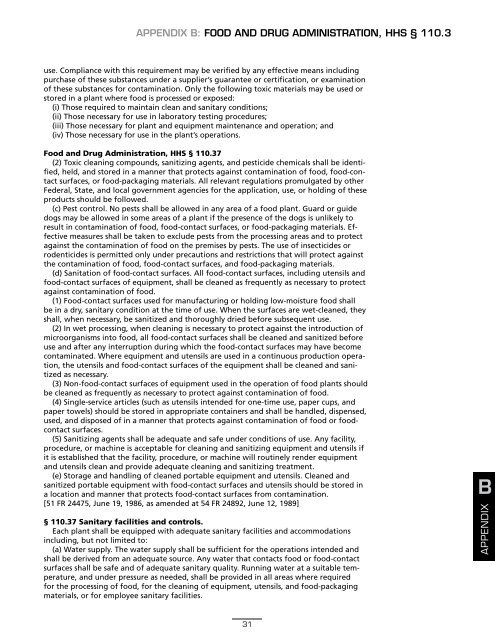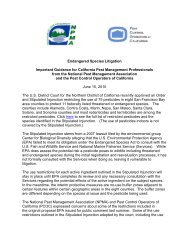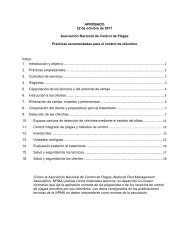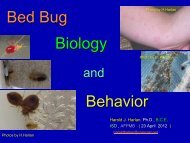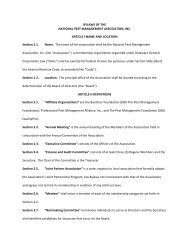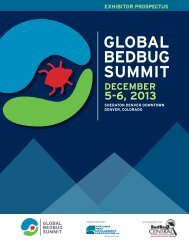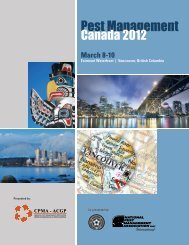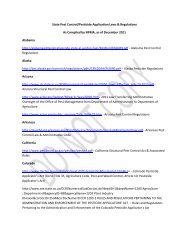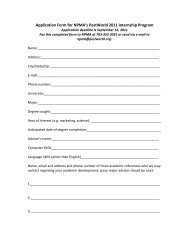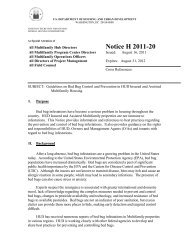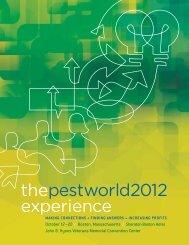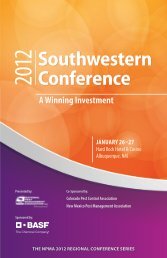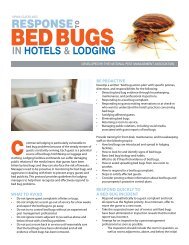Pest Management Standards For Food Plants - National Pest ...
Pest Management Standards For Food Plants - National Pest ...
Pest Management Standards For Food Plants - National Pest ...
You also want an ePaper? Increase the reach of your titles
YUMPU automatically turns print PDFs into web optimized ePapers that Google loves.
Appendix B: <strong>Food</strong> and Drug Administration, HHS § 110.3<br />
use. Compliance with this requirement may be verified by any effective means including<br />
purchase of these substances under a supplier’s guarantee or certification, or examination<br />
of these substances for contamination. Only the following toxic materials may be used or<br />
stored in a plant where food is processed or exposed:<br />
(i) Those required to maintain clean and sanitary conditions;<br />
(ii) Those necessary for use in laboratory testing procedures;<br />
(iii) Those necessary for plant and equipment maintenance and operation; and<br />
(iv) Those necessary for use in the plant’s operations.<br />
<strong>Food</strong> and Drug Administration, HHS § 110.37<br />
(2) Toxic cleaning compounds, sanitizing agents, and pesticide chemicals shall be identified,<br />
held, and stored in a manner that protects against contamination of food, food-contact<br />
surfaces, or food-packaging materials. All relevant regulations promulgated by other<br />
Federal, State, and local government agencies for the application, use, or holding of these<br />
products should be followed.<br />
(c) <strong>Pest</strong> control. No pests shall be allowed in any area of a food plant. Guard or guide<br />
dogs may be allowed in some areas of a plant if the presence of the dogs is unlikely to<br />
result in contamination of food, food-contact surfaces, or food-packaging materials. Effective<br />
measures shall be taken to exclude pests from the processing areas and to protect<br />
against the contamination of food on the premises by pests. The use of insecticides or<br />
rodenticides is permitted only under precautions and restrictions that will protect against<br />
the contamination of food, food-contact surfaces, and food-packaging materials.<br />
(d) Sanitation of food-contact surfaces. All food-contact surfaces, including utensils and<br />
food-contact surfaces of equipment, shall be cleaned as frequently as necessary to protect<br />
against contamination of food.<br />
(1) <strong>Food</strong>-contact surfaces used for manufacturing or holding low-moisture food shall<br />
be in a dry, sanitary condition at the time of use. When the surfaces are wet-cleaned, they<br />
shall, when necessary, be sanitized and thoroughly dried before subsequent use.<br />
(2) In wet processing, when cleaning is necessary to protect against the introduction of<br />
microorganisms into food, all food-contact surfaces shall be cleaned and sanitized before<br />
use and after any interruption during which the food-contact surfaces may have become<br />
contaminated. Where equipment and utensils are used in a continuous production operation,<br />
the utensils and food-contact surfaces of the equipment shall be cleaned and sanitized<br />
as necessary.<br />
(3) Non-food-contact surfaces of equipment used in the operation of food plants should<br />
be cleaned as frequently as necessary to protect against contamination of food.<br />
(4) Single-service articles (such as utensils intended for one-time use, paper cups, and<br />
paper towels) should be stored in appropriate containers and shall be handled, dispensed,<br />
used, and disposed of in a manner that protects against contamination of food or foodcontact<br />
surfaces.<br />
(5) Sanitizing agents shall be adequate and safe under conditions of use. Any facility,<br />
procedure, or machine is acceptable for cleaning and sanitizing equipment and utensils if<br />
it is established that the facility, procedure, or machine will routinely render equipment<br />
and utensils clean and provide adequate cleaning and sanitizing treatment.<br />
(e) Storage and handling of cleaned portable equipment and utensils. Cleaned and<br />
sanitized portable equipment with food-contact surfaces and utensils should be stored in<br />
a location and manner that protects food-contact surfaces from contamination.<br />
[51 FR 24475, June 19, 1986, as amended at 54 FR 24892, June 12, 1989]<br />
§ 110.37 Sanitary facilities and controls.<br />
Each plant shall be equipped with adequate sanitary facilities and accommodations<br />
including, but not limited to:<br />
(a) Water supply. The water supply shall be sufficient for the operations intended and<br />
shall be derived from an adequate source. Any water that contacts food or food-contact<br />
surfaces shall be safe and of adequate sanitary quality. Running water at a suitable temperature,<br />
and under pressure as needed, shall be provided in all areas where required<br />
for the processing of food, for the cleaning of equipment, utensils, and food-packaging<br />
materials, or for employee sanitary facilities.<br />
B<br />
APPENDIX<br />
31


